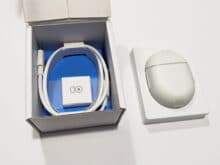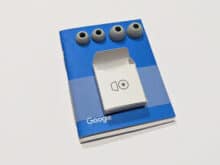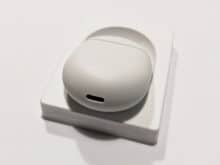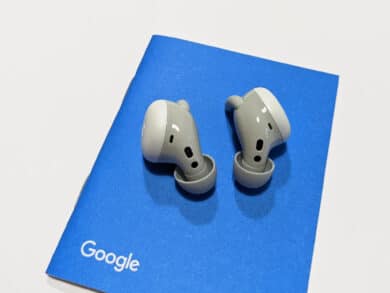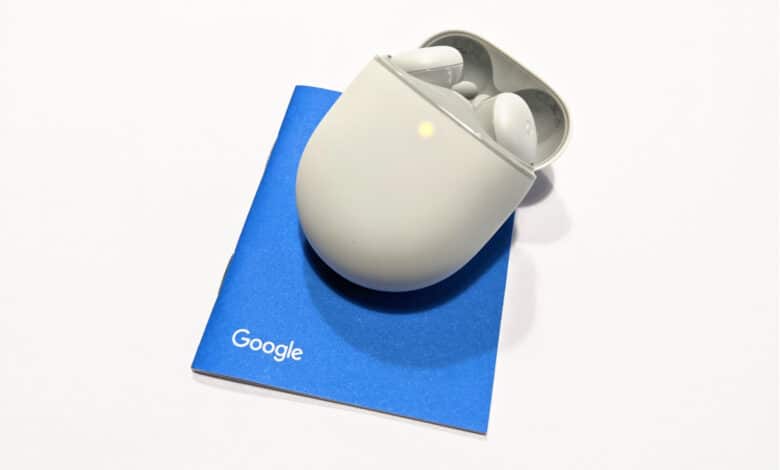
The first True Wireless in-ear headphones from the manufacturer, the Google Pixel Buds (2020), have been available since last year. The RRP of the Pixel Buds is 199 €, which puts them in the high-priced range. In the summer, a much cheaper model followed with an RRP of only €99. As we already know from the Pixel smartphones, this one gets the suffix A. The Google Pixel Buds A have been available in the colors Clearly White and Dark Olive since the end of August.
We took a closer look at the Pixel Buds A in the color Clearly White. We will clarify in the following review whether you have to make significant concessions and do without features for half the price or whether you get a good overall package at an attractive price, just like with the Pixel A smartphones.
Technical data
| Design | In-ear headphones, True-wireless with silicone wings | ||||
| Connections | Bluetooth 5.0 | ||||
| Control | Touch | ||||
| Driver | Dynamic 12 mm speaker drivers | ||||
| Features | IPX4 protection against water and sweat, wear detection using single IR proximity sensor, accelerometer for motion detection, voice assistant (Google Assistant) | ||||
| Charging port (charging case) | USB-C | ||||
| Battery life |
|
||||
| Size |
|
||||
| Weight |
|
||||
| Colors | Clearly White, Dark Olive | ||||
| Scope of delivery | Headphones, charging case, earbuds in 3 sizes, USB-C charging cable, quick start guide | ||||
| Price | € 73.02 * |
Scope of delivery
The Pixel Buds A come in a compact white box with the typical Google design, which is already known from the smartphones or even the Nest devices. After opening the box, you immediately look at the white charging case, in which the in-ear headphones are located. Furthermore, a short manual, the USB-C charging cable and two pairs of additional earbuds are included.
Design and workmanship
As already mentioned, the Google Pixel Buds A are true-wireless in-ear headphones. After opening the charging case, you look directly at the round and compact cases as well as the gray silicone wings, which are supposed to provide a better grip. The earphones and the silicone attachments are light gray, while the part that is visible when worn is white. The charging case also has a two-tone design. As with the earphones, Google relies on the colors light gray, for the inside, and white, for the outside.
The Pixel Buds A do not have any visible controls or buttons, but each has a touch element. The functions do not differ between left and right. All actions can be performed on each earpiece, so you have access to all options even when wearing only one earpiece. In addition, the Pixel Buds A each have a dual beamforming microphone.
The charging case is rounded and charges via USB-C, with the charging port on the bottom. Wireless charging is not supported. Apart from that, the case has an unobtrusive button on the back that activates the pairing mode. An LED also indicates the battery status. If the charging case is open and the LED is white, then the earphones are fully charged; if it is orange, then the earphones are still charging. If it is closed, then an orange LED signals a battery level of less than 20%, relative to the charging case.
We like the material quality and workmanship very much. The plastic feels pleasant, and there is also nothing to complain about in terms of workmanship. The only criticism is that the charging case is sturdy and resistant to scratches, but unfortunately somewhat susceptible to dirt. However, the dirt could be removed well with a dry to slightly damp cloth every time, so this did not annoy us for long.
Setting up and adjustment options
Pairing turns out to be very simple in connection with our Google Pixel smartphone. Immediately after opening the charging case for the first time, a notification pops up on the smartphone and we are asked if we want to pair the Pixel Buds A with our smartphone. If this is not the case with your smartphone, you can start the pairing mode via the small button on the back of the charging case.
After we agree to connect, the Google Assistant setup process starts, then you get to the options. With smartphones from other manufacturers, you might have to manually install the free Pixel Buds app from the Google Play Store or only this enables all setting options. In contrast to many other manufacturers, Google does without an unnecessarily bloated app and integrates the settings into the system settings, where they are found in the connected devices.
Within the settings you will find, among other things, a general guide (a kind of tutorial), settings for Google Assistant, a guide for touch operation, sound settings and more. The touch operation itself cannot be customized, but it is intuitive. Tapping once pauses or resumes playback, tapping twice jumps to the next song or three times jumps back to the beginning or the previous song. Many other manufacturers also use this type of operation. If you press the touch element longer, you can also call up Google Assistant, which informs you about the time and notifications or is also available for other functions. The Pixel Buds A do not have a volume control via touch or button. You either have to be satisfied with the automatic sound adjustment, more on that later, or the regulation via Assistant or smartphone.
Practical test and sound quality
In practical use, the Pixel Buds A convince with high wearing comfort, convenient functions and a good and balanced sound.
The size and weight of the Buds are very pleasant, so you hardly notice them in everyday use. Moreover, they fit very well and securely with the matching earbuds and especially thanks to the silicone wings. They do not sit too tight, hardly exert pressure on the ear and even with faster, jerky movements or the sprint to the streetcar you have no time to fear to lose them. Thanks to IPX4, you also don’t have to worry about rain or sweat.
The operation of the Pixel Buds worked very well in everyday use. The touch elements reacted directly and the desired functions were executed reliably. The wear detection, which pauses the music when the Pixel Buds are removed, also worked flawlessly at all times. While we were a bit skeptical at first due to the lack of volume control, we became very comfortable with the automatic sound adjustment over time. This temporarily increases the volume when your environment gets louder. In practice, this worked reliably and very well. When listening to a podcast, we adjusted the volume at the beginning, as usual. When we later crossed a busy street, for example, the volume increased so that we could still understand everything well. After we were back in a somewhat quieter environment, the volume was automatically lowered again to the level we had initially set. After a short time, we hardly missed the lack of manual control and rarely felt the need to readjust the volume ourselves.
Sound-wise, the Pixel Buds A are well tuned and rather neutral. The sound is clear, mids and highs are convincing, and there is fortunately no exaggerated and obtrusive bass. The bass boost can be used to help a bit, if desired. However, those who place great value on a pronounced, strong bass will not be happy here. Loud ambient noise is shielded well, but noise from wind, for example, is clearly perceptible. The microphones of the Pixel Buds A are also convincing in the test. Our voice was very well intelligible during phone calls, and ambient noise was mostly filtered out. We find the sound and microphone quality to be appropriate for the price.
Battery life
We were able to exceed the stated battery life of up to 5 hours, while listening to music, by about 30 minutes. With charging case, Google specifies up to 24 hours, and for pure calling, the two specifications are halved. 15 minutes of charging time are sufficient for 3 hours of playback, we can confirm this.
Even though these rates are sufficient in many cases, they are still only average. Other manufacturers partly offer much more here.
Conclusion
We can finally answer the question we asked at the beginning, whether the A stands for a good overall package at an attractive price here, as it does for the Pixel A smartphones, with a clear yes. The Google Pixel Buds A can convince us in the test with a good build quality, a high wearing comfort, a large feature set, and a good and balanced sound.
On the other hand, the battery life is rather average. Furthermore, Bluetooth 5.0 is supported, but we have to do without multi-connect as well as an HD or Lossless audio codec. Furthermore, there is no volume control, which we can do without thanks to the automatic sound adjustment.
Overall, the Pixel Buds A convince us, and we also find the price reasonable, but we also have to point out that the market is highly competitive and the selection is huge. The Pixel Buds A are a clear recommendation for those in the Pixel universe, but also worth a look for other Android users looking for comfortable and good true wireless in-ear headphones in this price range.
Google Pixel Buds A
Workmanship
Comfort
Sound quality
Recording quality
Features
Value for money
87/100
Compared with the Pixel Buds without the A suffix, you only have to do without a few things, but you save a lot. Overall, Google offers a compelling package.



